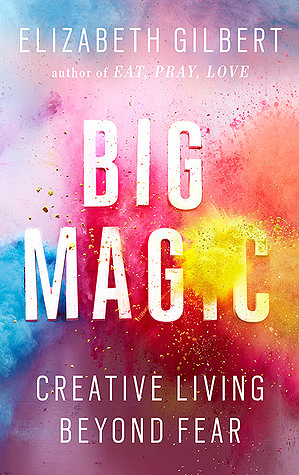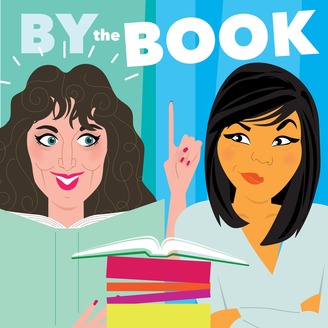 |
| The Cheryl Hahn painting in my dining room. |
And then, while I was doing the dishes or something boring, I decided to catch up on some episodes of By the Book, a hilarious podcast about self-help books that I've been listening to on and off for most of a year. I don't actually like self-help books, but I enjoy the podcast. Anyway, the book they were doing was Gilbert's Big Magic. What?
 |
| Big Magic by Elizabeth Gilbert |
The funny thing is, the way By the Book described Big Magic made me want to run from it. I hadn't read the subtitle, "Creative Living Beyond Fear" and that combined with it being pegged as a "self-help" book made it sound like something I would not enjoy. It sounded sappy, cheesy, and like something that's been done, even though the By the Book ladies both ended up recommending it.
 |
| By the Book Podcast |
This past Thursday was advising day and among many, many conversations about which courses are required for the AA, I had a really exciting conversation with a student about the feasibility of being an artist or, specifically someone who makes things with their hands. I basically told this student that if they really wanted to "make stuff" in their life, they could "make-up" the jobs that went along with it. I did a bunch of that in the years before and during my graduate school career, proposing art classes that didn't previously exist to city park and rec programs, and being paid only if the classes filled, teaching computers to senior citizens in one of those city programs (most surprisingly difficult class I ever taught), and selling my "boxes" and fountains at all manner of arts and crafts fairs.
 |
| the fountains were really a blast to make, a pain to set up each time, but overall lots of fun |
Just after having this conversation with the student, I'm reading this book where Gilbert is basically saying that if you want to "make stuff" in your life, you should just make time to do it, even if it isn't your "real job" and even if it doesn't make you any money. It wasn't exactly the same conversation, because ours had to do with making money and the benefits and challenges of "making stuff" for other people to pay the bills, but it was similar. And it resonated, as did the remainder of the book, with me about why we make art.
Around this time another coincidence of sentiment showed up in my life. One of my colleagues, Peter Monahan, is both a Spanish teacher and a filmmaker. He shared with me this video he had made about Janet Essley, an artist and educator in the Washington/Oregon area. The video is short, so definitely watch it. In the video, the artist talks about needing to make art, even though it isn't how she makes a living.
By this time I was really getting excited about Big Magic, the book and the stories within. Some pieces of it are a little woo-woo, like I'd rather call them coincidences or even stuff that reaffirms what I think is important, whereas Gilbert gives inspiration and creativity a kind of agency of its own. It reminded me of Marie Kondo thanking inanimate objects for their service. But I really enjoyed Gilbert's light hearted approach to both the book and "living a creative life."
She recommends taking risks, doing the work, following what seems like a random tangent in the work and not asking for any results in return: "Sometimes I think that the difference between a tormented creative life and a tranquil creative life is nothing more than the difference between the word awful and the word interesting." Gilbert recommends just finding everything interesting. Oh, I failed miserably? How interesting.
 |
| Last night when I was finishing up my latest sculpture, I starting thinking about how I might use marks on the surface of my ceramics that are similar in character to the marks in the zentangle-y Valentine's Cards. |
The best part of the book is the way Gilbert adds in these stories of "Big Magic" in her life or in the lives of her friends. The stories are funny, and fun, and inspiring (in a not sappy way). She tells the stories so well that I'm not going to try to capture them, because I actually recommend this book very highly, especially to people who want to "live a creative life."
I will relate one story, though; in it Gilbert recounts a situation where she sent in a short story for publication which was rejected with a nice note, then happened to (accidentally) send it in again to the same publication where it was accepted. "I saw it as another example of Big Magic....I saw it as proof that you must never surrender, that no doesn't always mean no."
My summary doesn't do Gilbert's writing justice, but I love the sentiment. This is how I approach improvements to our art program at YVC. A "no" one year might simply be a "not yet" and I tend to ask again when I feel the request will improve our offerings. I got one of these "no"s last week, and the book's reminder was nice, though I'd already put it on my "not yet" pile to be requested again next year.
I'm very glad I read the book. I will recommend it. It probably won't change my life, and the information and sentiments in it weren't exactly brand new to me, but they were a refreshing, joyful, engaging, and funny reminder that maybe I'm approaching this the right way.




















